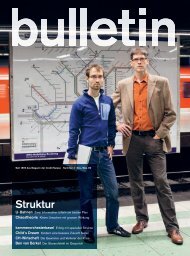Microfinance
Global Investor Focus, 02/20065 Credit Suisse
Global Investor Focus, 02/20065
Credit Suisse
Create successful ePaper yourself
Turn your PDF publications into a flip-book with our unique Google optimized e-Paper software.
GLOBAL INVESTOR FOCUS<br />
<strong>Microfinance</strong>—17<br />
contribution to achieving the UN Millennium Development Goals.<br />
Many investors, especially private investors, who target the microfinance<br />
market, do so with social objectives. While anecdotal evidence<br />
and surveys conducted among the recipients of microloans provide<br />
evidence of the genuine social impact, no universally acceptable<br />
standards exist yet for reporting on the social performance. Initiatives<br />
are targeted in this direction, but more efforts need to be put into<br />
developing and reporting standardized measurements of social impact<br />
at a reasonable cost.<br />
æ<br />
<strong>Microfinance</strong> harks back to the Raiffeisen idea<br />
The concept of microfinance is frequently publicized in the media<br />
through accounts of the success story of the Bangladesh-based<br />
Grameen Bank and its more than four million borrowers. Grameen<br />
Bank was founded in 1974 by Prof. Muhammed Yunus for the<br />
express purpose of extending microloans to needy women to<br />
assist them in helping themselves and improving their families’<br />
living conditions. In actuality, though, microfinance is not a novel<br />
invention. It is also no coincidence that the concept proliferated in<br />
western Europe in the second half of the nineteenth century. The<br />
Raiffeisen philosophy arose 150 years ago in Germany under difficult<br />
economic circumstances analogous to what one encounters<br />
today in many developing regions. On the cusp of industrialization,<br />
craftsmen and farmers suffered from a scarcity of financial resources<br />
because capital was being drawn to the higher returns promised<br />
by alternative investment opportunities such as railways and<br />
textile factories.<br />
The Raiffeisen model developed by mayor and social reformer<br />
Friedrich Wilhelm Raiffeisen was based on the self-help and solidarity<br />
principle. The farmers and craftsmen of individual villages<br />
banded together into cooperative associations. The members of<br />
each association declared their willingness to pledge their property<br />
as collateral for the cooperative’s liabilities. Since the members<br />
of the cooperative resided in an easily surveyable area, the<br />
character of the borrowers could be taken into account alongside<br />
their material property in the lending decision. The joint liability<br />
enhanced the creditworthiness of the cooperative members and<br />
gave them access to affordable business credit for the purchase<br />
of livestock, fodder, fertilizer and seed, and for their workshops.<br />
They also acquired a safe means of investing their savings. The<br />
Raiffeisen movement spread throughout the German-speaking<br />
world and beyond. The Union of Swiss Raiffeisen Banks was founded<br />
in 1902. In France, the same credit cooperatives go by the name<br />
Crédit Mutuel. And somewhat similar models emerged in other<br />
European nations such as Great Britain in the nineteenth century.<br />
Table 1<br />
Major lending methodologies in microfinance<br />
Source: Zeller, Manfred. Promoting Institutional Innovation in <strong>Microfinance</strong> – Replicating Best Practices is Not Enough.<br />
D+C Development and Cooperation, January 2000; Credit Suisse<br />
Cooperative model Solidarity groups Village banks<br />
Participation p The cooperative members are the owners p Ownership often unclear<br />
p 3 to 10 clients build a group<br />
Structure<br />
p Each cooperative is geographically limited<br />
p Joined support center exists (disbursement<br />
p Regional/central union<br />
of loans, collection of savings, etc.)<br />
Responsibility<br />
p Members vote/elected democratically<br />
p Support center makes decisions<br />
p Financial liability limited to own shares<br />
p Members collectively guarantee loan repayment<br />
p Equity capital build-up by members/the community<br />
p Highly decentralized<br />
p Ideally independent of any upper-level organization<br />
p Committee elected by, and among, members<br />
Profit sharing p Improve balance sheet or payout to members p Improve balance sheet; no distribution p Improve balance sheet or payout to members

















